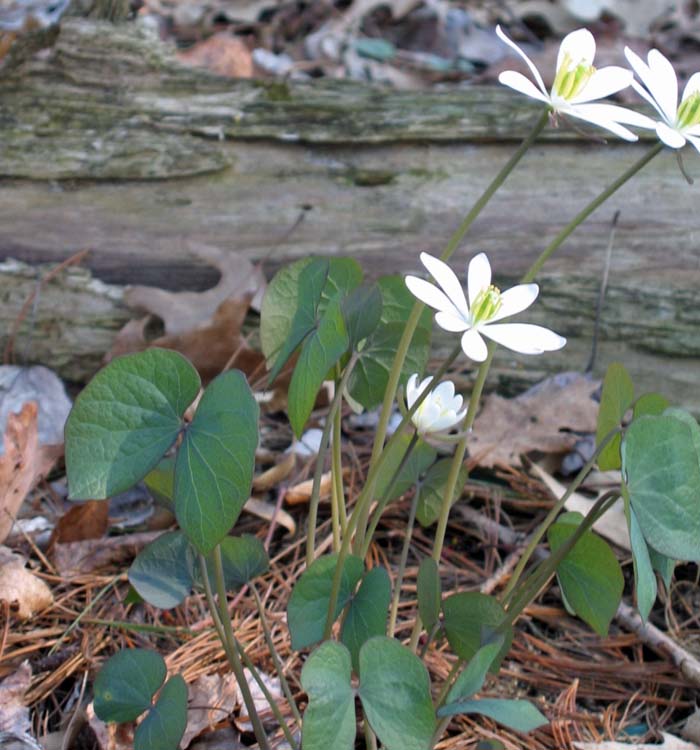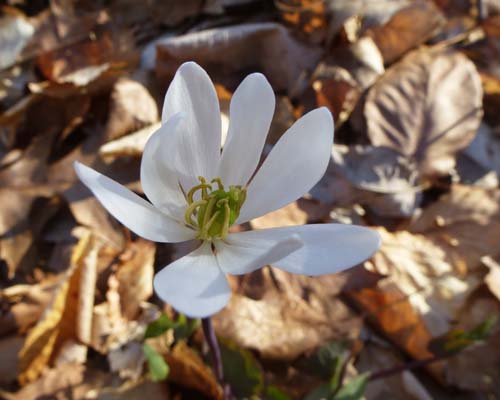Home Resources Gardener News reprints: Flower For A Day
This article by Hubert Ling (NPSNJ horticulture) was published in Gardener's News without the photos. He is a regular contributing writer to Gardener's News. Photos by H & M Ling.
Flower For A Day

Why plant something which will bloom for only one day in April? Twinleaf, Jeffersonia diphylla, commonly blooms for only one day although mature flowers may open the second day if they were prevented from fully opening by heavy rainfall. Generally all the flowers of a plant mature on the same day but flowers on plants in different locations in your yard may be a day or 2 off with their synchronous blooming. In any event if you miss the blooming day(s) you will have to wait until next year. However, on the positive side the plant many endearing attributes.
Jeffersonia diphylla is named after Thomas Jefferson our 3rd president who was dedicated to growing and utilizing all types of interesting plants. Currently Thomas Jefferson’s estate, Monticello, has a colony of twinleaf in a place of honor in the estate’s garden and vigorously promotes this plant. The species epithet ‘diphylla’ means two leaves or twinleaf. Other organisms have also been named for US presidents; for example a lichen, Caloplaca obamae, was named for President Obama in 2009
Twinleaf grows naturally in North-Eastern North America from Minnesota to Ontario, Canada and south to Alabama and Georgia. It is relatively rare in much of its range and twinleaf is one of our rarest plants in NJ (rating S1); however it is considered globally secure (G5). Twinleaf is also a threatened or endangered plant in Georgia, Iowa, and New York. Jeffersonia dubia, with blue flowers and found in Japan, is the only other species of twinleaf.
Our North American twinleaf grows to about 12-18 inches tall and has unique leaves, each with two large lobes which are about equal in size and shape; hence the common name twinleaf. Twinleaf grows naturally in neutral to basic, rich, moist limestone soil. However, twinleaf is sometimes found in areas with higher acidity. With its large twin leaves the plant grows best in deciduous, mature forests where it receives strong sunlight in early spring and then shade and higher moisture in the summer.

Twinleaf flowers are about 1 inch across and have 8 white petals often arranged to form a shallow cup. The petals may also open up completely and then twinleaf flowers appear very much like a bloodroot flowers although twinleaf is in an entirely different plant family. The plants do not produce nectar but do produce large amounts of pollen which attracts numerous pollinators especially bees. Twinleaf is considered by some people to be a spring ephemeral but is not a true ephemeral since the leaves persist through late summer.
After flowering twinleaf forms a 1-1.5 inch tall green, thimble shaped fruit topped by what looks like a green chocolate kiss hat. The bright green fruit looks very much like Kermit the Frog; the bottom of the ‘chocolate kiss’ represents Kermit’s mouth. When the fruit ripens Kermit’s mouth opens and 1-3 dozen light brown shiny seeds with white fleshy protrusions at one end are released. These white appendages are called eliasomes and are highly prized by ants. The ants carry twinleaf seeds back to their nests, then cut off the eliasomes and feed them to their larvae. The seeds are discarded on the rubbish pile where they readily germinate. Thus both partners in this relationship come out ahead. Eliasomes are also found in several other spring native plants such as violets, trillium, and bloodroot.
Given the correct conditions raising twinleaf is relatively easy. Be sure to plant the seeds immediately after the seed capsules open since the seeds rapidly go into dormancy which is not easily reversed. Germination of fresh seeds is rapid and highly successful. The seedlings mature in 4-5 years.
Twinleaf was used by North American natives internally for numerous ills and externally for inflammation, rheumatism, and sores. However, Peterson’s Medicinal Plants warns that it is probably toxic since the roots contain the alkaloid berberine. Also because of its rarity it should never be collected in the wild.
Consider growing twinleaf: it is beautiful, supports bees, has an interesting history, is highly shade tolerant (requiring), and is part of wild America which is rapidly disappearing.
For additional photos and information, click here